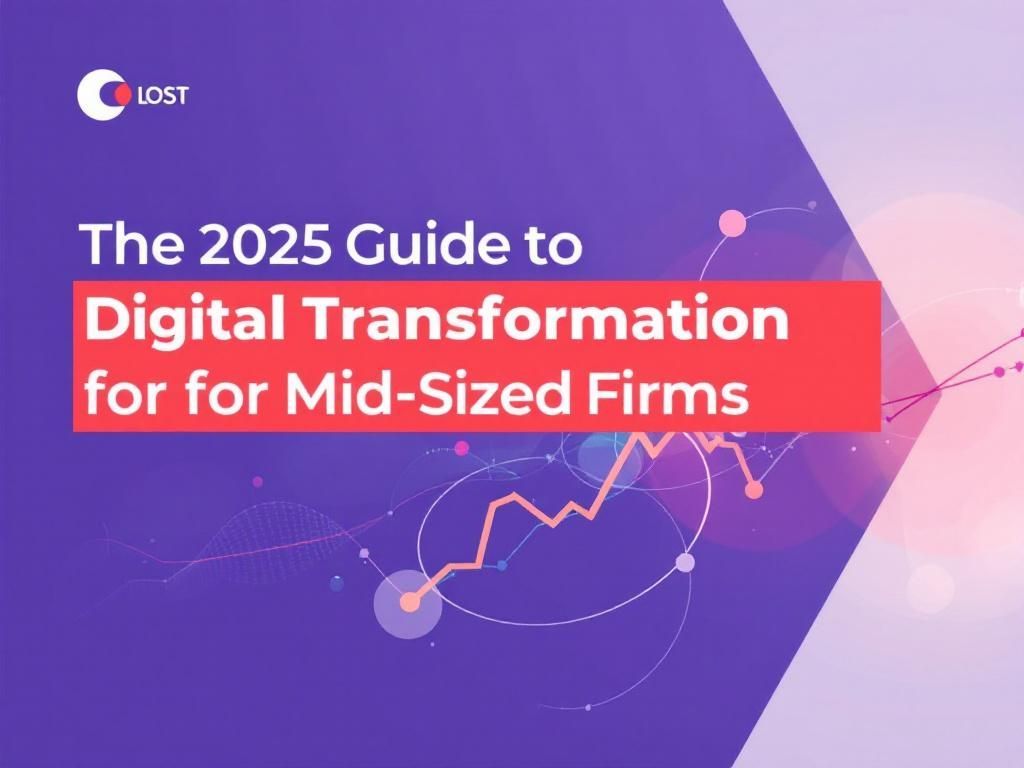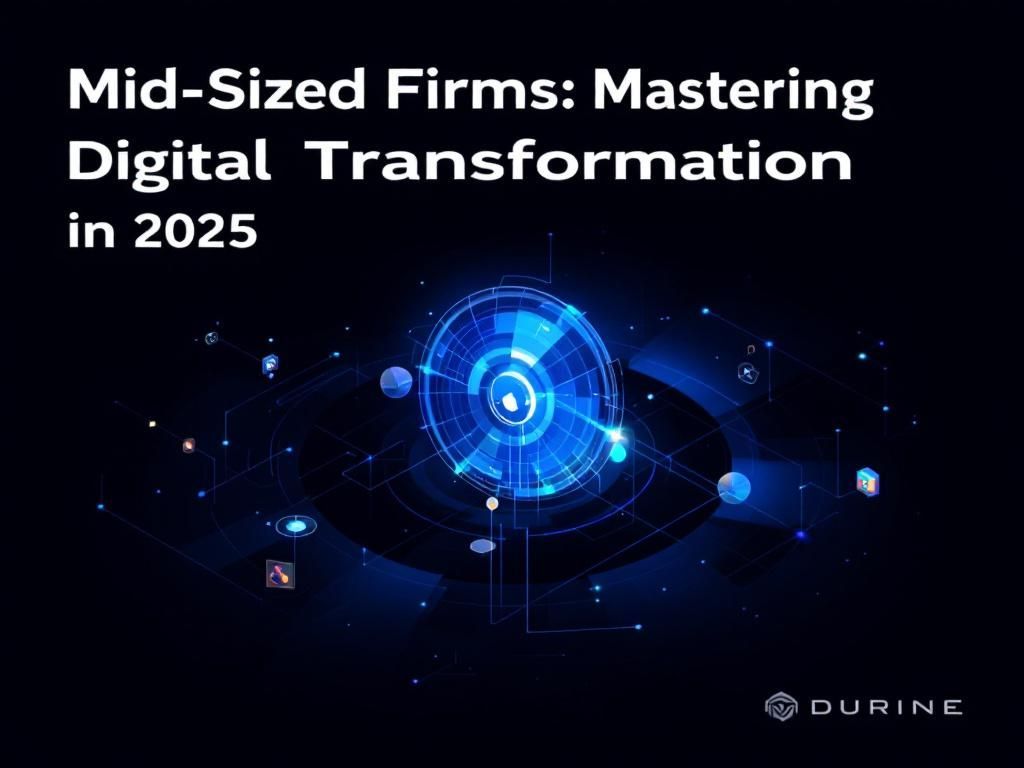2025 Guide to Digital Transformation for Mid-Sized Firms
Explore the essential strategies and tools for mid-sized firms to thrive in digital transformation by 2025.

As the world continues to evolve at an unprecedented rate, digital transformation has become an essential strategy for mid-sized firms aiming to stay competitive and thrive in the marketplace. This guide provides an in-depth look at the key components of successful digital transformation, the challenges firms face, and actionable strategies to implement change effectively. By embracing digital technologies and rethinking operational processes, mid-sized companies can enhance customer experiences, improve operational efficiency, and stimulate innovation.
Table of Contents
Understanding Digital Transformation
Digital transformation is more than just adopting new technologies; it’s about leveraging these tools to fundamentally change the way a business operates and delivers value to its customers. It encompasses a wide range of initiatives including:
- Process automation
- Data analytics
- Customer engagement strategies
- Employee collaboration tools
- Cloud computing solutions
The Need for Change
In today’s digital landscape, mid-sized firms face numerous challenges that necessitate a shift towards digital transformation:
- Increased Competition: Larger firms and startups alike are leveraging technology to enhance their operations, threatening the market share of mid-sized firms.
- Customer Expectations: Modern consumers expect seamless experiences across multiple channels.
- Operational Inefficiencies: Many mid-sized firms still rely on outdated processes that hinder productivity.
Key Components of Digital Transformation
1. Technology Integration
Investing in the right technology is crucial for a successful transformation. Mid-sized firms should focus on:
- Cloud Solutions: Moving to cloud-based platforms can enhance flexibility and scalability.
- Data Analytics: Utilizing data analytics tools to drive decision-making and improve customer insights.
- Cybersecurity: Implementing robust cybersecurity measures to protect sensitive data.
2. Organizational Culture
A successful digital transformation requires a shift in organizational culture. This can be achieved by:
- Encouraging collaboration among teams.
- Promoting a mindset of innovation and experimentation.
- Providing continuous learning opportunities for employees.
3. Customer-Centric Approach
The ultimate goal of digital transformation is to improve customer experience. Firms should:
- Utilize customer feedback to refine products and services.
- Implement CRM systems to manage customer relationships effectively.
- Personalize marketing efforts based on customer data.
Steps to Implement Digital Transformation
Step 1: Assess Current State
Before embarking on a digital transformation journey, firms should assess their current state by:
- Evaluating existing technologies.
- Identifying process inefficiencies.
- Gathering employee and customer feedback.
Step 2: Develop a Strategic Plan
A strategic plan should outline the key goals of the transformation along with measurable objectives. Consider using the SMART criteria:
- Specific
- Measurable
- Achievable
- Relevant
- Time-bound
Step 3: Invest in Technology
Investing in the right technology can be a game changer. Some popular tools include:
| Technology | Purpose |
|---|---|
| CRM Software | Manage customer interactions and data |
| Cloud Storage | Store and access data remotely |
| AI Tools | Enhance decision-making and customer interaction |
| Collaboration Platforms | Facilitate communication and teamwork |
Step 4: Train Employees
Employee training is crucial for a smooth transition. Strategies may include:
- Workshops and seminars on new technologies.
- Mentorship programs.
- Online courses and certifications.
Step 5: Measure Success
To assess the impact of digital transformation, firms should establish KPIs such as:
- Customer satisfaction scores
- Employee engagement levels
- Operational efficiency metrics
Challenges to Anticipate
Resistance to Change
One of the most significant barriers to digital transformation is resistance from employees. To overcome this:
- Clearly communicate the vision and benefits of transformation.
- Involve employees in the change process.
- Provide adequate support during the transition.
Budget Constraints
Mid-sized firms often operate under tighter budgets than larger corporations. Strategies to manage costs include:
- Prioritizing essential technologies for immediate impact.
- Exploring partnerships with tech vendors.
- Utilizing cloud solutions to reduce IT costs.
Future Trends in Digital Transformation
Artificial Intelligence
AI continues to shape the future of digital transformation. Its applications include:
- Chatbots for customer service.
- Predictive analytics for better decision-making.
- Automation of routine tasks.
The Internet of Things (IoT)
The IoT is revolutionizing data collection and analysis. Mid-sized firms can leverage IoT by:
- Enhancing supply chain management.
- Improving product tracking and inventory management.
- Gathering real-time data for better insights.
Conclusion
Digital transformation is not merely an option; it’s a necessity for mid-sized firms looking to survive and thrive in today’s fast-paced business environment. By understanding the components of digital transformation, developing a strategic plan, and anticipating challenges, businesses can successfully navigate this journey. As technology continues to advance, those who embrace change will undoubtedly find themselves at the forefront of their industries.
FAQ
What is digital transformation for mid-sized firms?
Digital transformation for mid-sized firms refers to the integration of digital technology into all areas of a business, fundamentally changing how these firms operate and deliver value to customers.
Why is digital transformation important for mid-sized companies?
Digital transformation is crucial for mid-sized companies as it enhances operational efficiency, improves customer experience, and enables firms to compete more effectively in a rapidly evolving market.
What are the key steps in the digital transformation process for mid-sized firms?
Key steps include assessing current capabilities, setting clear goals, adopting appropriate technologies, fostering a digital culture, and continuously measuring progress.
How can mid-sized firms overcome challenges during digital transformation?
Mid-sized firms can overcome challenges by prioritizing employee training, ensuring leadership support, and adopting a phased approach to implementation.
What technologies should mid-sized firms focus on for effective digital transformation?
Mid-sized firms should focus on cloud computing, data analytics, artificial intelligence, and customer relationship management (CRM) systems to drive effective digital transformation.
How can mid-sized firms measure the success of their digital transformation efforts?
Success can be measured through key performance indicators (KPIs) such as increased revenue, improved customer satisfaction scores, and enhanced operational efficiency.



